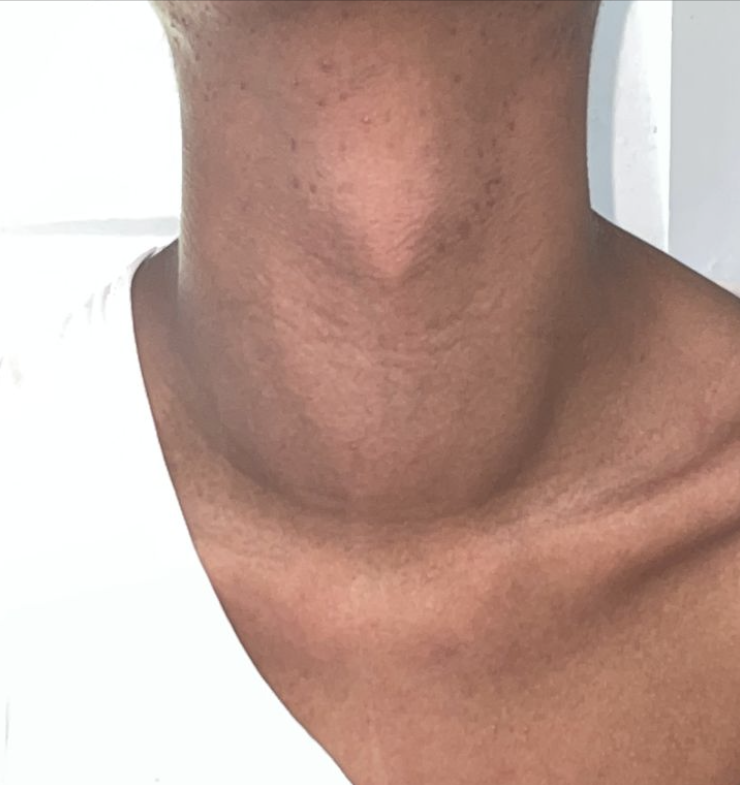Grave´s disease in a male adolescente, case report and literature review
Main Article Content
Abstract
Background: Hyperthyroidism is uncommon in the pediatric population, representing only 1-5 % of all hyperthyroidism diagnoses in the general population. However, 84-99 % of these cases are attributed to Graves' disease, with a peak incidence in adolescence and a higher prevalence in females (3:1 - 5:1). Despite its low incidence, Graves' disease is the most common cause of hyperthyroidism in childhood, characterized by autoimmune stimulation of thyroid-stimulating hormone receptors (TRAb), clinically presenting with goiter, hyperthyroidism, and infiltrative ophthalmopathy. Diagnosis is established by suppressing thyroid-stimulating hormone (TSH) levels, associated with the presence of antibodies against the TSH receptor (TRAb). Case Report:
In this document, we present the case of a male adolescent diagnosed and successfully managed with Graves' disease. Additionally, we provide a literature review on this condition with low pediatric incidence. Conclusions: The literature review emphasizes the need for early detection and proper management of this condition to prevent long-term complications. This case highlights the complexity of thyroid disorders in adolescence and the importance of an interdisciplinary approach for its management.
Downloads
Article Details

This work is licensed under a Creative Commons Attribution-NonCommercial-NoDerivatives 4.0 International License.
Creative Commons
License Attribution-NonCommercial-ShareAlike 4.0 International (CC BY-NC-SA 4.0)
You are free to:
Share - copy and redistribute the material in any medium or format.
Adapt - remix, transform, and build upon the material The licensor cannot revoke these freedoms as long as you follow the license terms.
• Attribution — You must give appropriate credit, provide a link to the license, and indicate if changes were made. You may do so in any reasonable manner, but not in any way that suggests the licensor endorses you or your use.
• NonCommercial — You may not use the material for commercial purposes.
• ShareAlike — If you remix, transform, or build upon the material, you must distribute your contributions under the same license as the original.
• No additional restrictions — You may not apply legal terms or technological measures that legally restrict others from doing anything the license permits.
References
Bengolea S v., Alonso G, Arcari A, Boulgourdjian E, Costanzo M, D’Amato S, et al. Thyroid disorders in childhood and adolescence. Part 1: Hyperthyroidism. Arch Argent Pediatr. 1 de febrero de 2021;119(1):S1-7.
Chiang YT, Ting WH, Huang CY, Huang SK, Chan CI, Cheng BW, et al. Long-term outcomes of graves disease in children treated with anti-thyroid drugs. Pediatr Neonatol. 1 de junio de 2020;61(3):311-7.
de Luca F, Salzano G, Zirilli G, Calafiore M, Corica D, Sferlazzas C. Management of hyperthyroidism in children. Vol. 11, Expert Review of Endocrinology and Metabolism. Taylor and Francis Ltd; 2016. p. 301-9.
Léger J, Oliver I, Rodrigue D, Lambert AS, Coutant R. Graves’ disease in children. Ann Endocrinol (Paris). 1 de diciembre de 2018;79(6):647-55.
Bettendorf M. Thyroid disorders in children from birth to adolescence. Vol. 29, European Journal of Nuclear Medicine. Springer Verlag; 2002.
Rivkees SA. Controversies in the management of Graves’ disease in children. Vol. 39, Journal of Endocrinological Investigation. Springer International Publishing; 2016. p. 1247-57.
De Luca F, Valenzise M. Controversies in the pharmacological treatment of Graves’ disease in children. Vol. 11, Expert Review of Clinical Pharmacology. Taylor and Francis Ltd; 2018. p. 1113-21.
Niedziela M. Hyperthyroidism in adolescents. Vol. 10, Endocrine Connections. BioScientifica Ltd.; 2021. p. R279-92.
Marques O, Antunes A, Oliveira MJ. Treatment of Graves’ disease in children: The Portuguese experience. Endocrinol Diabetes Nutr. 1 de marzo de 2018;65(3):143-9.
Cemeroglu AP, Kleis L, Wood MA, Davis AT. Reliability of early iodine 123 uptake for treatment of graves disease in children. Vol. 17, Endocrine Practice. 2011. p. 541-5.
Gastaldi R, Poggi E, Mussa A, Weber G, Vigone MC, Salerno M, et al. Graves disease in children: Thyroid-stimulating hormone receptor antibodies as remission markers. Journal of Pediatrics. 2014;164(5).
Cheetham T, Boal R. Graves’ disease.
Rabon S, Burton AM, White PC. Graves’ disease in children: long-term outcomes of medical therapy. Clin Endocrinol (Oxf). 1 de octubre de 2016;85(4):632-5.
Tong M, Ding J, Huang B, Chen J, Wei X, Li Z, et al. Evaluation of the application of TSH receptor stimulating autoantibodies and the optimization of detection strategy in Graves’ disease. Clinica Chimica Acta. 1 de octubre de 2021;521:34-9.
Mercado Cruz E, Fernando García Cubría C, Arellano Tejeda A, Rodríguez Huerta A, Gregor Sánchez Navarro Ciudad de México M, Correspondencia M. Tormenta tiroidea, una emergencia endocrina Presentación de un caso y revisión de la literatura. Vol. 60. 2017.
Rivkees SA, Pediatrics Y. The Treatment of Graves’ Disease in Children. Vol. 19, London Journal of Pediatric Endocrinology & Metabolism. 2006.
Li Y, Cui X, Yang Y, Liang Y, Chai F, Sun YC, et al. Surgical treatment of children Graves’ disease with huge goiter-A case report and literature review. Gland Surg. 1 de abril de 2020;9(2):467-73.
Ho YH, Chung EC, Park SA. A 3-year-old girl with Graves’ disease with literature review. Ann Pediatr Endocrinol Metab. 2014;19(3):154.
Elfenbein DM, Katz M, Schneider DF, Chen H, Sippel RS. Thyroidectomy for Graves’ disease in children: Indications and complications. J Pediatr Surg. 1 de octubre de 2016;51(10):1680-3.
Clemente V, Rojas M, Andrea M, Ortiz R. Hipertiroidismo congénito, Reporte de dos casos Congenital hyperthyroidism, report of two cases. Vol. 46. 2014.
Vargas-Uricoechea H, Sierra-Torres CH, Meza-Cabrera IA. (100) Págs. 41-66 • Marzo [Internet]. Vol. 35, MEDICINA. 2013.





